
This is a no-nonsense guide about how to update your existing surveillance system. Unlike other guides that discuss theories and hypotheticals, we break down the process so you can learn from it and do it on your own by selecting appropriate replacement equipment from CCTV Camera World.
Contents
- Check for Video Issues
- Check Which Type of Cable You Have Installed
- Thin Premade Cable - Analog Only
- HD Premade Cable
- RG59 Coax Cable from a Roll
- Ethernet Cable
- Ethernet Cable with Baluns for Coax Cameras
- Replacing Security Cameras
- Choosing Cameras for Your System Upgrade
- Replacing the Recorder in a Security System
- Running Into Issues With New Cameras?
Check the health of your current security camera system before making any changes or buying new equipment. That can be easily done by looking at the TV or monitor attached to the recorder to check for any pre-existing issues.
Check for Video Issues
Most of the time, video problems are usually apparent with Analog Security Cameras that run over BNC or Coax cable. IP security cameras that are connected to a computer network or NVR rarely have these problems, as most issues with IP cameras or existing network cables cause the camera to not operate at all.
The cause of issues with older analog CCTV cameras is usually due to worn-out or damaged cables that can cause damage to your old DVR or a new one. You should be on the lookout for any of the following issues:
- Strobing or rolling lines
- Ghosting
- Vertical lines
- Rainbow lines - like an old TV video test
- Glitchy video - video artifacting
- Video with off colors - usually shades of purple
- Video from a camera being duplicated on another channel
Here are a few examples we’ve received from our customers.
Common Video Issues with old CCTV Systems |
|
|---|---|
| Ghosting and Vertical Lines | 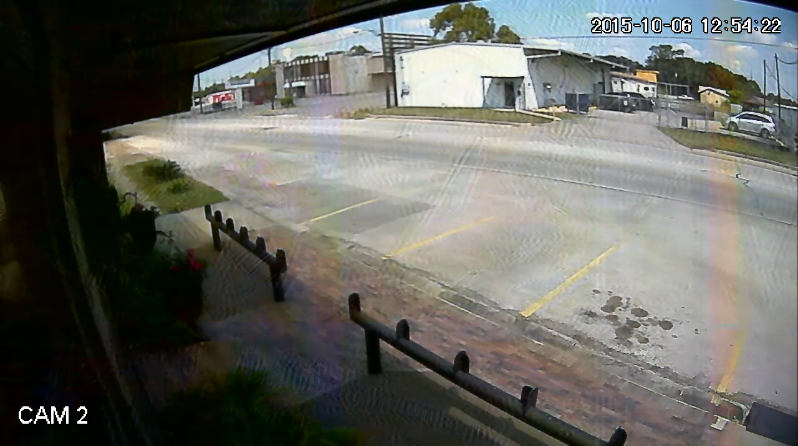 |
| Video Artifacts | 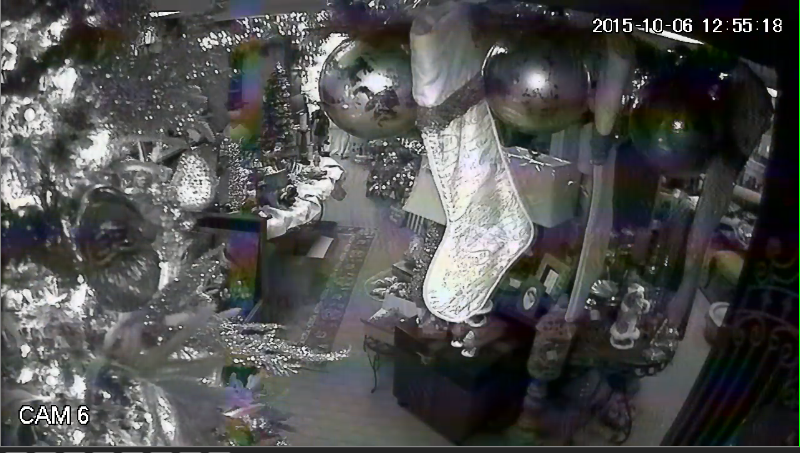 |
| Electrified surface |  |
If you have any of the above issues, they are usually related to an older security camera cable that requires replacement. Failure to do so in some instances will lead to damaging a new DVR recorder.
Check Which Type of Cable You Have Installed
If you have successfully ruled out video issues with your existing CCTV system, then it’s time to check which kind of cable you have. Depending on the type of cable you have, you may be able to upgrade your security cameras, or you may need to install new cabling. If you bought your system in a pre-made package from a big box store like Costco, Best Buy, or Sam's Club, you probably have thin pre-made cable, which is not recommended when installing high-definition security cameras. Below is a list of the types of security camera cables that you may already have:
1. Thin Premade Cable - Analog Only
Premade cable used in low-cost security systems sold by big-box stores is as thin as possible and contains small aluminum strands rather than a solid copper core. The combination of a thin gauge with aluminum strands means premade siamese cable can only be used with low-resolution analog cameras that record a maximum of 960H or 480P video. Rarely, some premade cable is strong enough to support 1080P over short distances up to 50 ft. Thin premade cable should not be used in a professional camera system, especially because manufacturers are trying to push the envelope with higher and higher resolution cameras running over coax.
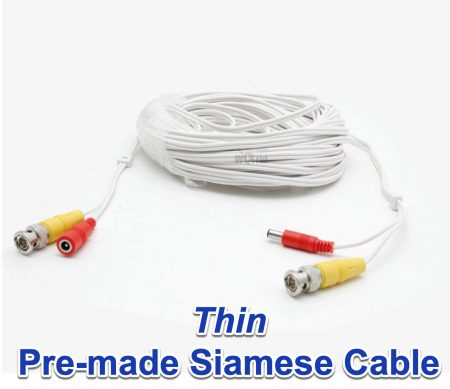
2. HD Premade Cable
Modern low-cost systems have Siamese cables that are premade and can be used with HD analog security cameras. HD premade cables are also made of stranded aluminum wire and have a thicker gauge than analog premade cables. This is not the same quality as the industry standard 20-awg solid copper coax wire. These cables come in a wide variety of aluminum gauges and are not standardized. While some cables may work fine with 1080P or 2K security cameras up to 150 ft., you have to be careful about potential ghosting over long distances. You can try to run 4K Security Cameras over HD premade cable that is specifically rated for 4K or 8MP. We have found that there are issues with power delivery due to the gauge of wire on the power side of the cable.
If you're looking for a quality picture from a 4K Analog Security Camera, we recommend using RG-59 coax wire.
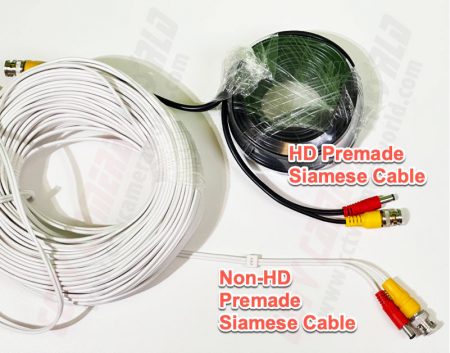
3. RG59 Coax Cable from a Roll
It is important to compare the different types of security camera cabling available for CCTV Cameras. Below is an image comparing the width of the two cable types discussed above with real RG-59 coaxial cable. As you can see, the thickness of the cables increases from thin premade to HD premade and then to RG59 coax, which is because the gauge of the wire inside is thicker. The more copper or aluminum there is inside the wire, the better it will perform. Of course, an all-copper wire is always better than an aluminum wire.
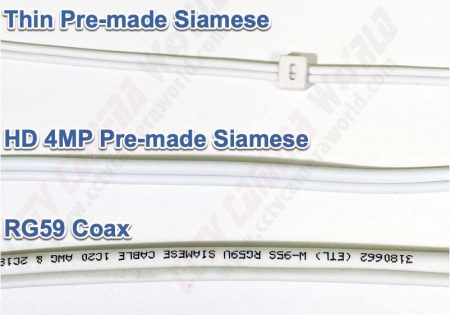
All Analog security camera systems should use cable from a roll of RG59 siamese wire, which is the gold standard for analog security systems. Although RG59 is more expensive and may seem hard to crimp properly and install, solid copper RG59 siamese cable can be used to run 4K security cameras until your power supply gives out.
On the other hand, the distance a camera can run over cable from a RG59 siamese roll varies greatly. Solid copper cabling supports longer transmission distances than copper-clad aluminum RG59 cable. If you’re interested in upgrading to 4K coax security cameras, then you will want to make sure you have or upgrade to solid copper cabling.
To learn more about the difference between Copper Clad Aluminum Cable and Solid Copper Cable, please look at the image below. It shows a cross-section of the cable that shows how the amount of copper in each type of cable is different.
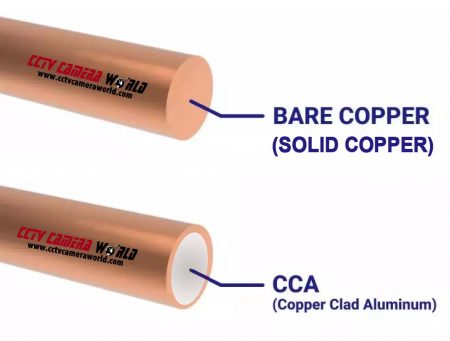
4. Ethernet Cable
Ethernet cable, also known as network cable, is a type of data cabling that connects IP network-based security cameras to a network video recorder (NVR) to form a Power-over-Ethernet system. In a PoE camera system, each cable has a distance limit of 328 ft. If you already have Ethernet cable installed that is working and are upgrading your old NVR or IP cameras, then you do not need to worry about replacing or upgrading your cable. The only reason to replace Ethernet cables in an NVR system is if you have a cable that does not work or if you would like to install a high-powered PTZ camera.
There are many different kinds of Ethernet cables available, depending on the gauge of the wire and whether they are bare copper (CCU) or copper-clad aluminum (CCA).
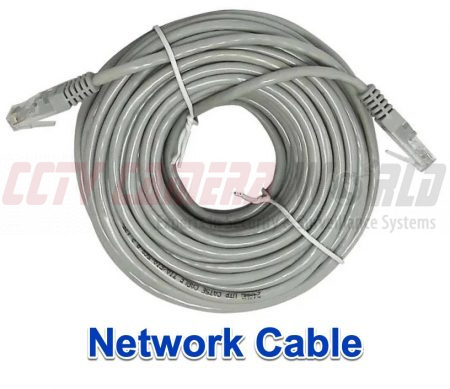
5. Ethernet Cable with Baluns for Coax Cameras
If you hired an installer or electrician when you installed your old system, they may have used Ethernet cable with converters called Video Baluns to install coaxial cameras. If you have small devices like the ones pictured below for each camera cable, then you have video baluns. Usually, video baluns use a 2-lead wire and terminate into a BNC connector.
If you have any of these, we recommend replacing them with new Ethernet cables and moving up to an IP security camera system.
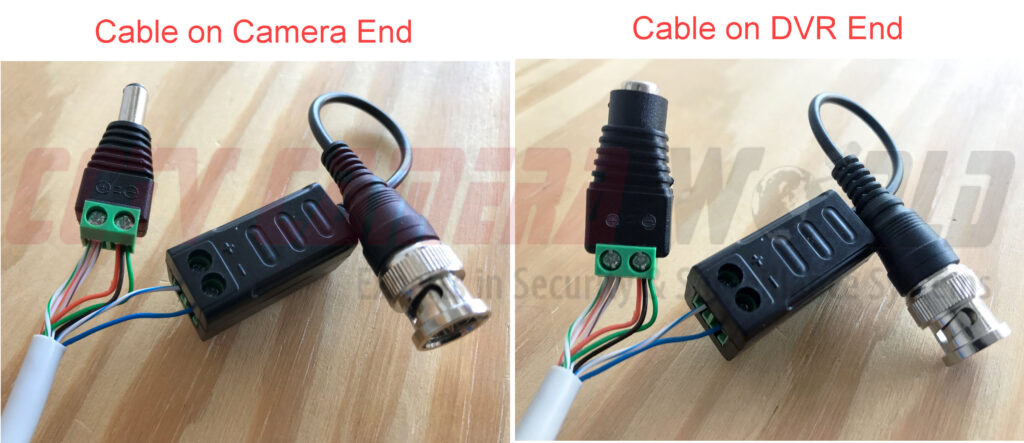
Replacing Security Cameras
Now that you know what kind of cable you have and the cameras it can support, it’s time to figure out how powerful you want your new security cameras to be. When clients contact us to upgrade their systems, they usually ask for 4K because it is widely marketed over the internet. However, you do not necessarily need to go with 4K surveillance cameras for your entire property. In fact, mixing and matching camera resolutions and features is the best way to save money and upgrade to the best security camera system for your home or business. Whether you plan to upgrade your cable or use the cable you already have will determine which cameras you can upgrade to.
Use Existing Coaxial Cable
If you already have good coax cable runs from a roll of solid copper coax, there's no reason to upgrade to an Ethernet IP camera system. Coaxial cables made of solid copper can send 4K video up to 600 ft. It is worth noting, though, that most 4K coax DVRs can only record 4K cameras at a maximum of 7 frames per second. 2K (4MP) coax systems can record up to 15 frames per second. If 7 or 15 frames per second does not record smooth enough video for your requirements, then consider upgrading to an IP camera system.
To understand what frames per second means, we suggest reading up about fps in our guide on how to choose security cameras.
Upgrade to Power over Ethernet Cameras
If you are sure that you want 4K cameras for your entire surveillance system, then we recommend replacing any existing coax cable with new Ethernet cable runs. Most PoE cameras don't necessarily care about the quality of the cable, but you can only run a single cable for 328 feet before needing extra hardware to extend the signal.
For cable runs longer than 328 feet, you would need Power over Ethernet (PoE) extenders that use a small amount of the line's amperage to boost the signal. There are problems with using extenders with high-powered motorized zoom security cameras or PTZ cameras. These problems include voltage and amperage loss.
You need to worry about the quality of the network cable when installing a high-powered PTZ camera. We recommend using only bare copper CAT6 cable that is 23 AWG.
Choosing Cameras for Your System Upgrade
With high-definition resolutions and the various features that cameras come with, it can be difficult to narrow down the selection. Besides the shape, there are four important things to think about when you want to replace your current CCTV cameras:
1. Resolution
Resolution is the most important consideration, as it determines how clear the video is. As we mentioned above, you can mix and match resolutions. For example, a 1080P camera will suffice in an area where you only need to see a face 20 feet away. If you need to see a face between 50 and 70 feet away, then consider a 4K camera.
The chart below is from our Security Camera Buying Guide and shows how far away you can expect facial detail using the different resolution cameras available.

2. Angle of view
The angle of view determines how wide a view a camera can see from where it is mounted. An example is a 90-degree angle of view in the corner of the room, from which you could see both sides of the room. Two 90-degree cameras in the front of a property would provide a 180-degree view of the front lawn or parking lot.
3. Night vision
Another important feature to think about is night vision, which will give you a general idea of what is going on where the camera is pointed at night. So, if a camera's description states it has 100 feet of night vision, that does not mean you can see a face that far in the darkness, but you will be able to tell whether someone is there. If it is a vehicle, you may be able to tell what the make and model is. Night vision uses infrared light to see in black and white.
The Starlight Technology that is found in some of our latest IP security cameras can record in color at night but requires adequate ambient lighting to do so. There is no such thing as color recording at night without ambient lighting.
Last but not least, there are cameras with white-light spotlights. Depending on the model of the camera, the light may stay on all night or only turn on when it senses motion.
4. Smart Motion Detection
The most important thing is that our professional PoE camera systems have a feature called "Smart Motion Detection" that uses AI to detect motion. PoE cameras and systems with smart detection improve the accuracy of motion detection by weeding out false positives and sending better alerts directly to a smartphone via push notifications. They also make it easier to find events in recorded video directly from your smartphone. Other features include audio detection, auto-tracking PTZs, and active deterrence.
If you’re looking for more information about choosing new security cameras, be sure to read our Security Camera Buying Guide.
Replacing the Recorder in a Security System
Upgrading the recorder in your security camera system is like upgrading to a brand new computer. A new recorder will let you upgrade to newer, more powerful security cameras and give you the most up-to-date features. If you have existing cameras that you would like to keep, be sure to contact us with the make and model of your cameras to find out what recorder you should purchase.
We recommend that customers replace their recorders first because, other than the cable, the DVR or NVR is what determines what cameras you can upgrade to.
Supported Resolutions
It’s important to pay attention to the spec sheet of a DVR or NVR to understand the maximum resolution that they can handle. If you attempt to connect an 8MP camera to a DVR that accepts a maximum resolution of 4MP or 5MP, then the DVR will show an error with no video, or the video will be glitchy.
As of today, all the NVR recorders we offer support 4K resolution. It is worth noting that there are 12MP cameras that are also 4K, while most NVRs support a maximum resolution of 8MP. 12MP cameras are the best of the best, and if you are considering purchasing one or more, make sure you purchase one of our NVRs that can handle them.
Compatibility Concerns
The second and equally important concern is compatibility. With coax cameras and DVRs, there are signal concerns. With IP cameras and NVRs, there are concerns with software compatibility.
Coaxial cameras transmit video data using different signal types. The four most common signal types for coax security cameras are HDCVI, HDTVI, AHD, and CVBS. CVBS is an old, non-HD analog signal used in traditional CCTV. If you try to use a camera that is the wrong signal type, then you can expect the DVR to show an error code, no video, or the video may look like our examples at the top of this article.
Purchasing a CCTV Camera World DVR or NVR
Regardless of whether you’re replacing an outdated DVR or you need a new NVR for your IP cameras, we have a professional security camera recorder for you. Our systems are better than those of our competitors because they come with Free Smartphone Apps and PC software for remote viewing that are easy to use. Using our video tutorials and written guides, you’ll be a pro at customizing your security camera system. Get alerted to events happening around your home or business with push notifications and email alerts sent directly to your phone.
Running Into Issues With New Cameras?
Even though it's usually easy to switch out recorders and cameras, not everyone will have a good time doing it. As with any technology, it’s not always as cut and dry as people make it out to be. Fortunately, we have the expertise to help you out and get you back up and running. If you purchase from our website, you’ll get free support via email for the life of the product, and we offer a paid phone support service with our US-based knowledgeable technicians. We have the following tips and tricks for each type of system to get you started with troubleshooting:
Analog Coaxial Cable System
- Check the health of your power supply box to make sure it is providing the correct voltage and sufficient amperage to power the new cameras you purchased.
- Check the health of your existing cables and replace any bad ones.
- Bench test any of the cameras that you think are not working with a short, known-good cable and test it with a dedicated power supply.
Power over Ethernet or IP Camera System
- You may need to manually enter in the password for your old cameras if you connect them to a new NVR. We have a guide for Adding QSee Cameras to an Avalonix NVR for more information. The process outlined in the guide is similar for other camera brands.
- If you’re connecting cameras over a separate PoE switch make sure that they are configured properly with compatible and unique IP addresses for your local network. Check out our guide on Setting Up An IP Camera System on the Network to learn more.
- Double check that the cameras you purchased are tested to be compatible with one another. Using cameras that have not been tested for compatibility will lead to unexpected results.

